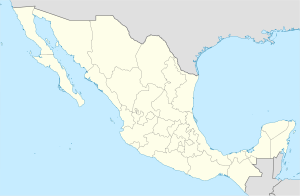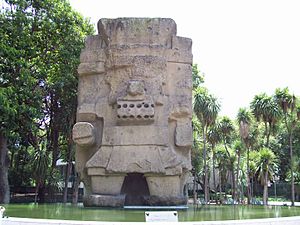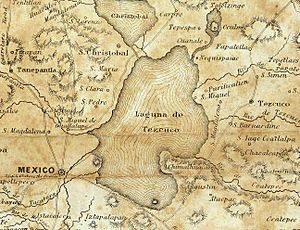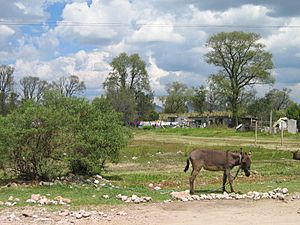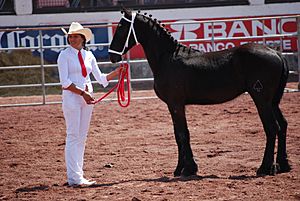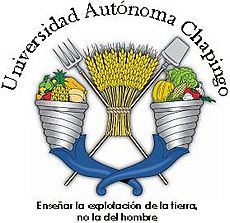Texcoco de Mora facts for kids
Quick facts for kids
Texcoco de Mora
|
||
|---|---|---|
|
City
|
||
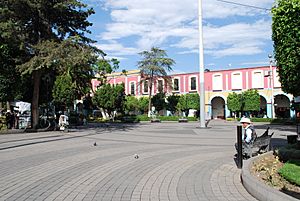
Part of the main plaza
|
||
|
||
| Country | ||
| State | State of Mexico | |
| Municipality | Texcoco | |
| Founded | 1551 (as Spanish city) | |
| Municipality Created | 1919 | |
| Area | ||
| • City | 418.69 km2 (161.66 sq mi) | |
| Elevation
(of seat)
|
2,250 m (7,380 ft) | |
| Population
(2005) Municipality
|
||
| • City | 259,308 | |
| • Seat | 259,260 | |
| Time zone | UTC-6 (Central (US Central)) | |
| • Summer (DST) | UTC-5 (Central) | |
| Postal code (of seat) |
56100
|
|
| Website | Official site: https://archive.today/20100125231625/http://www.texcoco.gob.mx/inicio | |
Texcoco de Mora is a city in the State of Mexico. It is about 25 kilometers northeast of Mexico City. Texcoco de Mora is the main town of the Texcoco municipality.
Long ago, before the Spanish arrived, Texcoco was a very important Aztec city. It was located right on the shores of Lake Texcoco. After the Spanish conquest, Texcoco was one of the most important cities, second only to Mexico City. But over time, it became more like a countryside area.
Over many years, most of Lake Texcoco was drained. Now, the city is no longer on the lake's edge. Many old Aztec items have been found here. One famous find is a huge 125-ton stone statue of Chalchiuhtlicue. This statue was found near San Miguel Coatlinchán. Today, you can see it at the Museum of Anthropology in Mexico City.
Recently, Texcoco has seen some disagreements between its people and the government. One big issue is the idea of building an airport here. Even though the current Mexico City airport is very busy, many local people do not want a new airport in Texcoco.
The city and its area have many ancient sites. These include the palace of Nezahualcoyotl and Texcotzingo, also known as the Baths of Nezahualcoyotl. Other important places are the Cathedral, the Juanino Monastery, and Chapingo Autonomous University. The biggest yearly event is the Feria Internacional del Caballo, which means International Horse Fair. It shows off the area's farming roots.
Contents
What's in a Name?
The official name of the city is Texcoco de Mora. The "de Mora" part honors Dr. José María Luis Mora. But most people just call it Texcoco.
The name Texcoco comes from the Nahuatl language. It probably means "among the jarilla plants that grow in rocky places." However, old pictures of the name, called glyphs, have been found. These glyphs are in old documents like the Codex Azcatitlán. Because of these different pictures, the exact meaning of the name is not 100% certain.
Texcoco's Past
Ancient History
The Paleontological Museum in Tocuila shows very old animal bones. These bones are from animals that lived a long time ago. They were found where a river used to flow into Lake Texcoco. We don't know the exact date when people first lived in Texcoco. But it is likely that the first people were Toltec or from Teotihuacan.
Old writings say that the first people here were from a group called Chichimeca. This group started a region known as Acolhuacan in the ancient Valley of Mexico.
Some of the most famous rulers of Acolhuacan lived in Texcoco. These rulers were strong leaders and priests. They greatly shaped the history of the valley. The most famous ruler was Nezahualcoyotl. He helped create the Aztec Triple Alliance. During his 40 years as ruler, art, culture, and buildings grew very well in his land.
Spanish Colonial Times
Hernán Cortés first came to Texcoco in 1519. At that time, Cacamatzin was the leader. In 1521, Cortés built boats called brigantines here. He used these boats to attack Tenochtitlan. There is a tall stone monument on Juárez Street that marks this event.
After the Spanish took over the Aztec Empire, Franciscan friars came to Texcoco. They came to teach Christianity. Important friars included Juan de Tecto, Juan de Ayora, and Pedro de Gante. Pedro de Gante started the first primary school in Mesoamerica. He taught Latin, Spanish, and skills like sewing and carpentry. He also wrote the first book of Christian teachings in Nahuatl. There is a chapel in the Texcoco cathedral named after him.
In 1551, a local leader named Fernando Pimentel y Alvarado asked the Spanish king to make Texcoco a city. The king agreed and gave Texcoco a special symbol, a coat of arms. This symbol had Spanish designs but also Aztec images like a coyote. In the early colonial period, Texcoco was the second most important city in New Spain.
After Mexico's Independence
Even though Texcoco was important at first, it did not grow into a big city like some other places. For a long time, it was mainly known for fishing and farming. From 1827 to 1830, Texcoco was the second capital of the State of Mexico. Later, in 1861, the name "de Mora" was added to honor Dr. José María Luis Mora. In 1919, Texcoco became a modern municipality.
In 1903, a huge 125-ton statue of Tlaloc was found in Texcoco. Today, this statue stands in front of the National Museum of Anthropology in Mexico City. The local people did not want the statue moved. They even tried to stop the vehicles that came to take it away. There is a plan to put a copy of the statue back where it was found.
In 2003, experts found many ancient items in an area planned for an airport. These items were found near the old shores of Lake Texcoco. They included pottery, tools, and ceremonial objects. These finds help us understand how water levels changed over hundreds of years.
In 2005, people who sell traditional crafts protested in Texcoco. They blocked main roads because they did not want to be moved away from the city cathedral. They said that the area is important for selling their goods, especially during holidays. Many families depend on these sales during festivals like Day of the Dead and Christmas.
In 2006, there were more protests involving merchants and farmers. They blocked a highway to show their concerns. Flower sellers wanted public space to sell their flowers. Supporters from a nearby town joined in the protests.
Texcoco's Geography
Texcoco is about 25 kilometers east of Mexico City. The area has several mountains. The Tlaloc Mountain is very tall, reaching 4,500 meters. There are also smaller mountains like Tetzcutzinco. Many mountains are named after the towns on them.
A part of the municipality used to be covered by Lake Texcoco. But most of this lake has been drained over time. Rivers like the Cozcacuaco and the San Bernardino still flow.
The city of Texcoco used to be right on the shore of Lake Texcoco. This lake was once very large. But since early colonial times, people have drained it to prevent floods. This has almost made the lake disappear. Since the 1970s, there have been efforts to clean the remaining parts of the lake. About 1,700 hectares of the lake remain. You can still see water birds and migratory birds from the U.S. and Canada there.
The climate in Texcoco is mild and somewhat dry. The average temperature is about 15.9 degrees Celsius. Most of the rain falls between June and October. The higher mountains have forests with pine and oak trees. The drier lowlands have plants that grow in semi-desert areas. You might see deer, coyotes, and ocelots. Smaller animals are also common. Sadly, some larger birds like falcons and eagles are no longer found here. Most reptiles, except for rattlesnakes, have also disappeared.
Population
In 2005, the Texcoco municipality had a population of 259,308 people.
Texcoco's Economy
Texcoco still feels like a rural area. It does not have many big factories like some nearby towns. Because of this, many people who live here travel to other places for work. They might go to Mexico City or other towns. The large amount of traffic passing through Texcoco can cause smog.
About 60% of the municipality is covered by forests or tree farms. About 25% of the land is used for farming. Most farms are family-owned. They grow fruits like avocados, plums, apples, and pears. They also grow corn, beans, and wheat. Flower farming started here in the mid-1900s. It is done in several communities like San Simón and San Miguel Coatlinchan. Most livestock raised here are dairy cattle. These are found on ranches like Xalapango. Recently, some industries related to farming have started. A main craft made here is blown glass.
Culture and Community Life
In the early 1970s, people wanted to create a fair to show off Texcoco's farming and animals. The first flower fair was held in 1975, but it was not very successful. In 1978, the fair changed its focus to horses. This created the first Feria Internacional del Caballo (International Horse Fair). Special buildings were built for it, like a bullring and stables. This horse fair has been very successful and happens every year.
The fair takes place at the end of March. It includes music shows, horse events, and displays of animals, businesses, and crafts. One of the main events is bullfighting. Traditional crafts made here include blown glass, clay pottery, and painted dried plants. These plants are often used as Christmas decorations.
The city also has a yearly cultural festival called the Festival Cultural Nezahualcoyotl. Many artists have performed there. In 2008, artists from Italy and Chile joined the festival for the first time. This ten-day event has activities related to dance, music, painting, crafts, and reading.
The Feria de la Cazuela happens in July in Santa Cruz de Arriba. This event features traditional crafts, especially pots, jars, plates, and trays.
The old Hacienda of El Molino de Flores is now the Molino de Flores Nezahualcóyotl National Park. It is three kilometers east of the city. This hacienda used to make a drink called pulque and grow grains. Most of its buildings, like the main house and the church, were built by Miguel de Cervantes and his wife. The hacienda became a national park in 1937. Because of its old style, it has been used as a setting for many movies.
Important Places to See
The center of Texcoco city has the palace of Nezahualcoyotl, the Cathedral, and the Chapel of Gante. There is also a Casa de Cultura, which has a small museum. The Palace of Nezahualcoyotl is also known as the archeological zone of Ahuehuetitlan. This palace had at least 300 rooms and five courtyards. It also had a Mesoamerican ball court and a special shrine. In the large halls, Nezahualcoyotl and his wife would meet visitors. There were also rooms for music, poetry, and studying the stars.
The Mexico State government approved the state's first constitution at the old Juanino Monastery. The Casa de Cultura has murals by artist José Marin. These murals show different parts of Mexico's history. Puerto de Bergantines is where Hernán Cortés built his boats to attack Tenochtitlan in 1521. A tall monument marks this spot.
The most important ancient site outside the city is Tetzcutiznco or Tetzcotzingo. People often call it the Baths of Nezahualcoyotl. It is on a hill in the community of San Miguel Tlaminca. This site has a complex water system, terraces, shrines, and thrones. About six buildings have been dug up and are open to visitors. This site was a retreat for Nezahualcoyotl. It was most important around 1466 and covered a large area.
The water system included 10 kilometers of canals. A 4-kilometer aqueduct brought water from 9 kilometers away. People thought these were baths because of the large water tanks. But the water was actually used for beautiful gardens. These gardens had plants from far away places. The idea that they were baths came from paintings made in the late 1800s.
Another story about the site is that there were tunnels leading to Teotihuacan. In reality, the underground passages were likely caves. They were damaged when people looked for treasure in 1847. Digging by INAH began in 1981, but much of the site is still hidden. The site has been damaged by people writing on it. A part called the Patio of the Gods is still used for ceremonies. These ceremonies celebrate the spring equinox and Nezahualcoyotl's birthday.
In San Luis Huexotla, there is another ancient site. It has a round pyramid dedicated to Ehecatl, the god of wind. There are also parts of a wall and a ball court. The San Luis monastery was built in 1627 next to this site. It is a Baroque style building. It is one of the smallest of its kind in the Americas.
These ancient sites are not widely promoted for tourism. They also have few services for visitors.
Getting Around Texcoco
There are regular bus services to Metro Indios Verdes, a station for the Mexico City Metro.
Since the late 1990s, there have been plans to build a new airport near Mexico City. Texcoco has been one of the proposed locations. However, people in Texcoco and nearby towns have strongly opposed building an airport in their areas. There were protests in Texcoco in 2001 and 2002. Even though the current Mexico City airport is very busy, local residents continue to object to new airport construction here. The most recent idea to build an airport in Texcoco was in 2008.
Learning in Texcoco
Just south of the city is Texcoco's most famous school, the Chapingo Autonomous University. This is a public university. It offers technical degrees and full bachelor's degrees. It also has science and technology research programs. Many of these programs are about farming, forests, and fishing.
The school started in 1854 as the National School of Agriculture. It was moved in 1923 to the old Chapingo Hacienda. In 1959, they added programs for advanced studies. The school became independent in 1978. It offers courses in forestry, farming economics, and more.
The main attraction for visitors at this school is its murals. In the old hacienda chapel, which is now the University Ceremonies Room, there is a mural by Diego Rivera. It is called "Tierra Fecundada" (Fertile Land). This artwork was started in 1924 and finished in 1927. It covers a very large area. It shows man's struggle for land, the growth of Mother Nature, and the connection between humans and the earth. Many people think it is one of Rivera's best works.
More recently, the school got a mural by Luis Nishizawa. This work shows Mexican agriculture from the past and present. It is very tall and wide. It is in a building often called "El Partenon." The school also has the National Museum of Agriculture. This museum covers the history of farming in Mexico. It has about 4,000 objects, including old farming tools and photographs.
Other schools in Texcoco include the Centro Universitario UAEM Texcoco and the Universidad del Valle de Mexico. The latter opened in 2004 and has a large library open to everyone.
Places of Worship
The Texcoco Cathedral was built on the site of a 16th-century Franciscan monastery. It was rebuilt in 1664 as the Parish of San Antonio de Padua. The complex also had the first European-style school for native people in Mesoamerica. You can still see Latin letters on some of its columns. Only parts of the original 16th-century monastery remain.
The city celebrates the feast day of Saint Anthony of Padua, its patron saint, on June 13. Another festival is the Molino de Flores, which happens on Pentecost. Juan Manuel Mancilla Sanchez became the bishop of Texcoco in 2009.
Sports
The Emperadores de Texcoco football team plays in the Mexican Football League Second Division. They play at the Papalotla Stadium.
Media
La Uni-K (XHOEX-FM) is a community radio station. It broadcasts on 89.3 FM.
Notable People
Mayors
- Mauricio Valdéz Rodríguez (1973–1975)
- Silverio Pérez (1976–1978)
- Isidro Burgos Cuevas (1991–1993)
- Héctor Terraza González (1994–1996)
- Jorge de la Vega (1996–2000)
- Horacio Duarte (2000–2003)
- Higinio Martínez Miranda (2003–2006)
- Constanzo de la Vega (2006–2009)
- Amado Acosta García (2009–2012)
- Arturo Martinez Alfaro (2012–2013)
- Delfina Gomez Alvarez (2013–2015)
- Joel Huerta (2015–2020)
See also
 In Spanish: Texcoco de Mora para niños
In Spanish: Texcoco de Mora para niños



